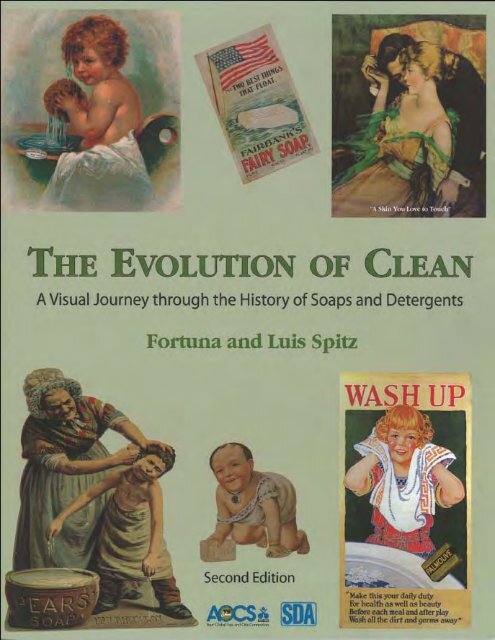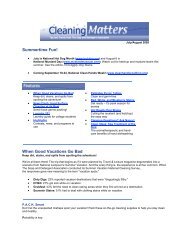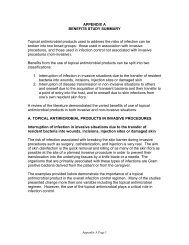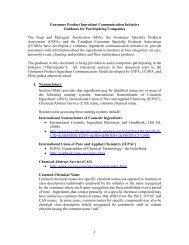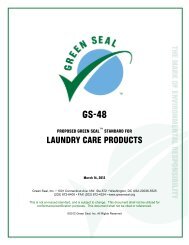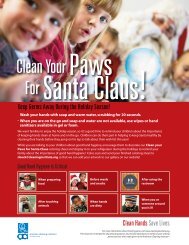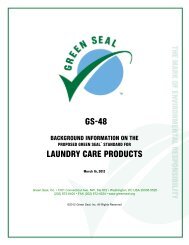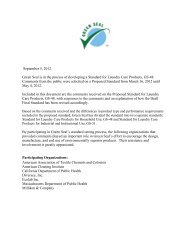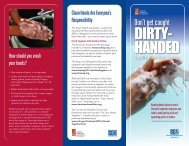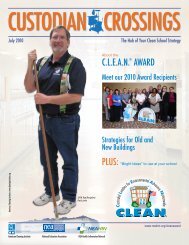Download - The American Cleaning Institute
Download - The American Cleaning Institute
Download - The American Cleaning Institute
- No tags were found...
You also want an ePaper? Increase the reach of your titles
YUMPU automatically turns print PDFs into web optimized ePapers that Google loves.
Acknowledgement<strong>The</strong> Soap and Detergent Association is proud to have contributed to the updating of this volume, especially aswe reflect on the 100th anniversary of a great organization: AOCS.<strong>The</strong> photographs and artwork showcased here reflect products that have contributed to the health and quality oflife of millions of people around the world.We can also point to the countless contributions of chemists throughout the past century that have led to theformulation and manufacturing of beneficial hygiene and cleaning products. Many of these chemists have beenmembers of AOCS.Our Association is proud to be a partner and strong supporter of AOCS, showcasing groundbreaking technicalwork and scientific advances in cleaning product chemistry.Innovations in chemistry are now contributing to the development of more sustainable cleaning products andpractices that we look forward to highlighting with AOCS in the years ahead.We also extend our thanks once again to the authors of this book, Fortuna and Luis Spitz, for opening up theirarchives and vast reservoirs of knowledge that are displayed here for generations to come.SDA hopes that you will learn much from and enjoy delving into the history of soaps, detergents and cleaningproducts, so beautifully captured in the second edition of <strong>The</strong> Evolution of Clean.Ernie RosenbergPresident & CEO<strong>The</strong> Soap and Detergent AssociationDisclaimerWhile SDA is a sponsor of this publication and the author of Chapter 10, it is not responsible for the companies selected to be featured or any other content of thispublication.© 2009 <strong>American</strong> Oil Chemists’ SocietyAll rights reserved.
<strong>The</strong> Early YearsAfter the Rain, Grace T.Hallock, Cleanliness<strong>Institute</strong>, 1927. <strong>The</strong> bookwas supplementalreading for third, fourth,and fifth grades and dealtwith cleanliness customsof children in many lands.In 1926, a few years before the dawn of the GreatDepression, a group of U.S. manufacturers banded togetherin New York City to promote the benefits of cleanliness andhygiene.That organization was known as the Association of<strong>American</strong> Soap and Glycerine Producers, Inc. (AASGP),forerunner of <strong>The</strong> Soap and Detergent Association (SDA).Mr. Roscoe Edlund was the first manager of the Association,and by 1931, there were 84 members.<strong>The</strong> name changed to SDA in the 1960s to reflect theemergence of synthetic surfactant-based products. Whenthe Association was founded, its original Certificate ofIncorporation laid out some very specific objectives:Glycerine soap is mainstay of industry.Cleanliness issues among schoolchildren become highpriority.Handwashing In Schools: A Study by the Cleanliness <strong>Institute</strong>found that children were not washing hands after toilet useor before eating; time, supervision and facilities were limited;and children enjoyed washing hands if made convenient andpleasant.<strong>The</strong> Association of <strong>American</strong> Soap and Glycerine Producers(later to be renamed <strong>The</strong> Soap and Detergent Association)developed an in-school hygiene program and worked withschools and public health groups to promote cleanliness inhomes and in schools.Materials were distributed to schools throughout the 1930sand 1940s via the Cleanliness <strong>Institute</strong>.A Tale of Soap andWater, Grace T. Hallock,1927. <strong>The</strong> book wassupplemental reading forseventh, eighth, andninth grades on thehistorical progress ofcleanliness andsanitation.• “…collecting and circulating information valuableand useful to the public with reference to the use ofsoap and kindred products.”• “…investigating the nature and use of glycerineand kindred substances and disseminatinginformation with reference thereto.”• “…promoting the best interests of producers ofsoap and glycerine and kindred products.”In 1927, <strong>The</strong> Cleanliness <strong>Institute</strong> was founded by theAssociation to teach the value of hygiene. <strong>The</strong> <strong>Institute</strong>published and disseminated educational materials incooperation with public and private organizations includingschools and health, social, and welfare agencies to improvehygiene practices.<strong>The</strong> techniques promoted by the <strong>Institute</strong> were developedcooperatively with these partners and were based upon thehighest standards of that day. <strong>The</strong> joint efforts resulted inconstructive programs and activities that were of greatvalue to leaders in public service and industry.During its 35 years of existence, the <strong>Institute</strong> served thepublic by raising personal and community standards ofhealth, self-respect and productivity. It contributed to thegeneral welfare by strengthening public consciousness ofthe value of cleanliness standards by reaching out tovirtually the entire population of the United States.140
One of the first projects of the <strong>Institute</strong> was a 1928investigation of school handwashing facilities. <strong>The</strong>research involved 145 schools in 15 states, representing atotal enrollment of 124,000 students, and was supportedby Colgate-Palmolive-Peet Co., Lever Brothers Co., Pine TreeProducts Co., and <strong>The</strong> Procter & Gamble Company. <strong>The</strong>study revealed great interest in cleanliness education inschools.In its early years, like today, the Association focused heavilyon public education and outreach with a heavy emphasison the health benefits of cleaning products. It also madesavvy use of the available media of the time. Following anassessment of media opportunities in the radio era, itestimated that a combination of news feature releases,editorial matter, and radio broadcasting could reach anaggregate population of more than one billion people inthe early 1930s. <strong>The</strong> use of strategic media remains ahallmark of SDA’s activities today.<strong>The</strong> <strong>Institute</strong> supplemented the Association’s work byproducing advertisements for the available media, with aparticular emphasis on mass-circulation magazines. <strong>The</strong>seefforts reached a population of more than 34 million<strong>American</strong>s.And, how was the consumer reaction to the campaignmeasured? In the simplest way imaginable. Eachadvertisement carried a coupon exchangeable for one ofthree booklets. In total, over 1.1 million booklets weredistributed. On one peak day, 38,000 coupons werereceived at the <strong>Institute</strong>’s office.Learn the Art of Magic, Happy Goldsmith, Cleanliness<strong>Institute</strong>, 1928. This booklet was designed to teach childrencleanliness facts in an amusing and appealing way.<strong>The</strong> Smart Thing to Do, Happy Goldsmith, Cleanliness<strong>Institute</strong>, 1927. This engagement book for young ladiesshared suggestions for the smart thing to do on alloccasions.Cleanliness Broadcasts,Cleanliness <strong>Institute</strong>, circa 1930s.A series of eleven 15-minutetalks were broadcast over anational network by <strong>Institute</strong>staff. Each broadcast waspublished in pamphlet form anddistributed to the public for free.SDA: PROTECTING FUTURE GENERATIONSMastodons, Microbes,and Man, W.W. Peter,Cleanliness <strong>Institute</strong>,1931. <strong>The</strong> 26-page bookwas for high schoolstudents and adults andtaught practicalcleanliness as a protectivemeasure against disease.HITCH-HIKERS, Cleanliness <strong>Institute</strong>, 1930. A 56-pagebooklet was illustrated to explain how the graphic term“hitch-hikers” may be applied to the organisms ofcommunicable diseases. It was designed to help reducethe incidence of communicable diseases, by securingbetter individual supervision of the routes to the mouthand nose.141
<strong>The</strong> Middle YearsOver the years, as the cleaning products industry evolved,so did the Association. In 1946, the SDA Board of Directorsapproved a two day convention, featuring a luncheon, anannual meeting, and a Board meeting. Eventually,manufacturers of cleaning product ingredients,oleochemical producers, and suppliers of finishedpackaging became eligible to join SDA.Mr. Roy Peet led the Association for 10 years, beginning in1952. By the end of 1953, the Association had grown to171 members. <strong>The</strong> portfolio of the organization’s work alsoexpanded to include:• Cleanliness promotion• A census of industry sales• A statistical service to members• A periodical and literature digest• A Washington consultant• Transmittal of Federal Defense agency orders,regulations, and control to members• Circulation of government invitations to bid• Keeping abreast of State and Federal legislation• Serving as an information center about the industry• Holding an Annual ConventionIn the Association’s middle years, new technology createdthe need for new products. Consumer’s cleaning habitschanged when automatic dishwasher powders, liquidlaundry detergents, hand dishwashing soaps, all-purposecleaning products, fabric softeners, and detergents withoxygen bleach were brought to market.Additionally, the Association continuously publishedtechnical and scientific papers on the human health andenvironmental safety of cleaning product ingredients,especially surfactants.Fatty Acids: Building Blocksfor the Industry, Associationof <strong>American</strong> Soap andGlycerine Producers, 1951.<strong>The</strong> publication describedfatty acid processing fromrefining the crude fats,through splitting anddistillation, to their finalproducts and uses.Lave and Learn, RoscoeC. Edlund, Cleanliness<strong>Institute</strong>, 1931. Areproduction of anarticle appeared in theCleanliness Journal inApril 1931. It reportedon a study conductedby the <strong>Institute</strong> thatrevealed that the handsof America’s 25,000,000school children werenot washed as often asneeded.<strong>The</strong> Dynamics of the SoapIndustry, Association of<strong>American</strong> Soap andGlycerine Producers, Inc.,1954. <strong>The</strong> 28-page bookletcontained the presentationbased on a talk given atRutgers University by RoyW. Peet. <strong>The</strong> bookletcontained the fascinatinghistory of cleanliness, soapproduction, soapconsumption, andcleanliness promotion.SDA: PROTECTING FUTURE GENERATIONS143
By 1953, there is widespread use of detergents. Newtechnology creates need for new products. Environmentalissues begin to surface.Full voluntary conversion to LAS in large-scale commercialproduction is achieved by cleaning product manufacturersin 1965 to solve water quality problems.A series of Detergents-in-Depth symposiums began,bringing the latest cleaning products research directly togatekeeper/educator audiences.Enzymes in Laundry Products, SDA, 1972. <strong>The</strong> bookletprovided consumers with the answers to the mostfrequently-asked questions on enzymes, their use, andsafety.Home Safe Home, SDA, 1976. Thisbrochures was created for thosewho work with pre-school childrenand was used by Departments ofFamily and Children Services, SocialServices, Public Welfare, PublicHealth, Head Start, and day carecenters. Nearly 16 million wereprinted.SDA Technical Advisory Council is founded. A series oftechnical reports on surfactants is developed:• Detergents and Water Pollution Abatement,1965• Field Test of LAS Biodegradability, 1965–1966• Surfactant Effects on Humans and Other Mammals, 1966• Test Procedure and Standards —ABS and LASBiodegradability, 1966Extensive environmental research was conducted oncleaning product ingredients in conjunction with the federaland local governments. <strong>The</strong> industry worked together tocoin the term “biodegradable.”In 1962, the Association officially changed its name to <strong>The</strong>Soap and Detergent Association. <strong>The</strong> Cleanliness <strong>Institute</strong>became the Consumer Education Department.Also at that time, SDA partnered with the HealthCommissioner of New York City, the National TuberculosisAssociation, and the National Safety Council to educate thepublic about the importance of cleanliness. Later in thesixties, member companies donated soap for distribution tocivilians in Vietnam through the US Information Service.HousekeepingDirections, SDA, 1976.<strong>The</strong> brochure helpedachieve longer usageof apparel andhousehold furnishingsand prepared itsaudience for gainfulemployment inhousehold-relatedoccupations. Used byU.S. Department ofAgriculture, HUD, StateEducationdepartments, andwelfare agencies.Clean and Neat Is Hardto Beat, SDA, 1969. Thisbooklet encouragedchildren to developgood health habits andwas used by Head StartCenters, public schools,child welfare agencies,etc.144
SDA broke new ground in 1974 by bringing interestedparties together for the first “Detergents-in-Depth”symposium, held in Washington, D.C., to stimulate dialoguebetween industry and consumer communicators. Morethan 30,000 copies of the proceedings of the symposiumwere distributed to libraries, educators and the media.<strong>The</strong> Chair of that 1974 symposium, Judith Smeltzer of FMCCorp. said at the time,“Government can draft more andmore legislation. Agencies can regulate. Consumerorganizations can advocate. But in the final analysis, thesecret to a successful future for our industry is consumertrust and confidence. And as we all know, there is only oneway to achieve trust in what we do and confidence in whatwe make. We have to earn it.”<strong>The</strong>se symposiums continued until 1992 and weresuccessful in sharing current information with consumerrelatedorganizations.SDA also broke new ground in the late 1970s with theissuance of its critical reviews of human and environmentalsafety data of major surfactants. <strong>The</strong>se reviews precededthe US and international programs by two decades andcalled for the compilation of data on all high productionchemicals in commerce.Glycerine Series, SDA, 1960sPhysical Properties of Glycerine and its Solutions. <strong>The</strong>compilation shared the more important of the availabledata on glycerine and its aqueous solutions, containing anumber of tables and graphs for ready reference and anextensive bibliography.Chemical Properties and Derivatives of Glycerine. Thisbrochure covered the chemical reactions of glycerine,both those of primary industrial interest and also manyof its reactions that are primarily of scientific andindustrial interest with no current commercialsignificance.Uses of Glycerine. This booklet discussed the manyhundreds of uses of glycerine from adhesives to woodand tobacco treatments.Glycerine: Terms, Tests, Technical Data. <strong>The</strong> bookletdetailed the various grades of glycerine, as well astesting methods and how to handle and store glycerine.SDA: PROTECTING FUTURE GENERATIONSDetergents-in-Depth, SDA, 1972, 1974, 1976, 1978,1980, 1984 and 1992. <strong>The</strong> books are the proceedingsfrom SDA symposiums.145
End of a CenturyCleanliness and the HealthRevolution, SDA, 1984.<strong>The</strong> 68-page book detailedhow changes in personaland environmental hygieneplayed an essential role inthe health revolution in theU.S. and England.<strong>The</strong>re was growing concern about the environmental andhuman safety of household cleaning products near the endof the century. Lack of time was a key issue for theexpanding work force. Rapid technological advancementsin new appliances lead to new cleaning products in themarketplace.In 1984, SDA published Cleanliness and the Health Revolution,detailing how changes in personal and environmentalhygiene played an important role in the health revolution inthe western world. Later, the Association produced AHandbook of Industry Terms as the first comprehensivedictionary of terms used in the soap and detergent industry.<strong>The</strong> handbook was used by communicators, educators, themedia, and the government—all seeking a betterunderstanding about cleaning products.A Handbook of IndustryTerms, SDA, 1987. <strong>The</strong>dictionary contained morethan 200 terms used in thesoap and detergentindustry.A series of environmental safety monographs on detergentswere published on:• Linear Akylbenzene Sulfanate• Sodium Hypochlorite• Polycarboxylates• Dihydrogenated Tallow Dimethyl Ammonium Chemicals• Boron<strong>The</strong> SDA created extensive consumer publications toaddress changes in technology and products:• Understanding Automatic Dishwashing, SDA, 1983offered consumer information on how to usedishwasher detergents effectively and safely.Glycerine: AnOverview, SDA,1990. <strong>The</strong> brochuredetailed the terms,technical data,properties, andperformance ofglycerine.• Fact Sheet Notebooks, SDA,1992–1999 containedin-depth information on laundry, dishwashing, andhousehold cleaning products are used by CooperativeExtension Agents and community educators acrossthe USEnvironmental outreach became the educational focus:• Recycle It!, SDA,1991• What Can I Do?, SDA,1995• Septic Tank Systems and Household <strong>Cleaning</strong> Products,SDA,1997Work Practices for Handling Enzymes in the DetergentIndustry, SDA, 1995. This document providedinformation and recommendations on practices for thesafe handling of enzymes for use by management,safety professionals and employees in the cleaningproducts industry. It also describes a medicalsurveillance program that employers can use to helpensure employee health and safety in the workplace.146
<strong>The</strong> New CenturyToday’s SDA remains committed to improving the lives ofpeople through scientific research and education-basedresults. Its Principles of Sustainable Development will be theblueprint for the mark left on and beyond the new century.Among those challenges are growing threats to SDAmembers’ ability to freely innovate, formulate, and marketproducts that serve their customers’ needs and, in the process,serve the companies’ need to grow and return value to theirshareholders. Proposed restrictions on chemicals in generaland on cleaning and personal care products in particular,including their ingredients and packaging, are realimpediments to growth.SDA is uniquely positioned to enhance the reputation of itsmembers as positive contributors to society at-large. In-houseconsumer education and outreach efforts have cementedalliances with government agencies like the Centers forDisease Control and Prevention and the Consumer ProductSafety Commission. External communication efforts havesolidified the Association’s reputation as the industry’s voice,speaking out on issues on high-profile morning and eveningnews broadcasts and in other news media reaching millions of<strong>American</strong>s.On the scientific and technical front, SDA is a well-knownsource of expertise on responsible stewardship of chemicaldata. Its management of industry High Production Volume(HPV) consortia is enriching the world’s understanding of over200 chemicals.<strong>The</strong> SDA continues to be actively engaged in advocating arisk-based approach to consumer product management atthe national and international levels. This will help assurethat consumers are getting useful cleaning products alongwith the information they need to use them safely.SDA will continue to reach out to government officials,scientists, academicians, consumers, the media, and industrythrough legislative, regulatory, technical, and educationalactivities to advocate:• safe use of its members’ products• basic research on the human health and safety of theproducts• risk-based assessment for purposes of product andingredient management• dialogue and collaborations among industry, government,and the public• enhanced public health and well-being through improvedhygiene and sanitationPrinciples for Sustainable Development, SDA, 2004.This publication describes the principles designed tohelp advance human health and environmental quality,social well-being, and economic growth of SDA membercompanies.Clean and Safe forthe 21st Century,SDA, 2004. <strong>The</strong>brochure advocatessafe product useand storage.Risk Assessment Guidancefor Enzyme-ContainingProducts, SDA, 2005. Thisdocument provides guidanceon the risk characterizationprocess in the developmentof new products containingenzymes. This information isintended for use by industrialtoxicologists, risk assessors,and product safetyprofessionals to support theirdevelopment of appropriate risk managementstrategies that avoid unacceptable risks to the users ofenzyme-containing products.SDA: PROTECTING FUTURE GENERATIONS147
SDA Presence on the World Wide WebRealizing the influence of the Internet to reach millions ofpeople around the world, SDA launched <strong>Cleaning</strong>101.com in1997 and over the years SDA has created several additionalsites to expand science-based information about cleaningproduct safety, benefits and sustainability.Exposure and Risk Screening Methods for ConsumerProduct Ingredients, SDA, 2005. <strong>The</strong> book containsmethodologies and specific consumer exposureinformation that can be used for screening-level riskassessments of environmental and repeated humanexposures to high production volume chemicalsthrough the manufacturing and use of consumerproducts, mainly laundry, cleaning, and personal careproducts.• <strong>Cleaning</strong>101.com—This web site contains news andresources for consumers, educators, SDA membercompanies and reporters. Much of the educationalmaterials posted on this site are available for the public todownload and copy, helping SDA reach millions withmessages about the benefits and safe use of cleaningproducts.• ItsaSNAP.org—In 2003, SDA partnered with the Centersfor Disease Control and Prevention (CDC) to introduceSNAP (School Network for Absenteeism Prevention). Thisprogram is a hands-on initiative for middle schools that isdesigned to help keep students in school and learning byimproving overall health through promoting clean hands.<strong>The</strong> SNAP web site provides resources for teachers, schoolnurses and students who are interested in promotinghand hygiene in their school.• SDA Sustainability Central—(www.cleaning101.com/sustainability), launched in 2006, communicates thesustainability and product stewardship efforts of SDA’smember companies.• <strong>Cleaning</strong>ProductFacts.com—In April 2007, SDAlaunched this site, giving consumers a new onlineresource for information on the safety and effectivenessof household cleaning products. <strong>The</strong> web siteconsolidates much of the science-based information onhow cleaning products are formulated, used anddisposed of safely.High Efficiency Washers and Detergents, SDA, 2005.This consumer booklet, developed by the detergentand appliance industry, helps consumers understandhow HE detergents and washers work.• AgainstDisease.org—compiles the historical andtechnical record on the role of sanitation, medicaladvances, cleanliness and hygiene on public health andinfection control. <strong>The</strong> site makes available at no cost adownloadable version of SDA’s companion volumeAgainst Disease: <strong>The</strong> Impact of Hygiene and Cleanliness onHealth.• SDAScience.org—In November 2008, SDA debuted thissite, which shares publicly SDA’s vast portfolio of researchon the safety and benefits of cleaning products and theiringredients.148
Awards<strong>The</strong> Soap and Detergent Association honors individualsand groups through a variety of award programs for theirefforts in promoting the goals of the cleaning productand oleochemical industries.C.L.E.A.N. TM AwardDeveloped through a partnershipbetween the National EducationAssociation (NEA),<strong>The</strong> Soap andDetergent Association (SDA) andCenters for Disease Control andPrevention (CDC), this award will recognize thecontributions that custodians make to public health intheir schools, communities, and their profession.SDA Distinguished Paper AwardPresented annually to the authors of the best technicalpaper appearing during the preceding year in the Journalof Surfactants and Detergents (JSD), a publication of the<strong>American</strong> Oil Chemists' Society (AOCS).SDA Elva Walker Spillane Distinguished Service AwardRecognizes an individual who has demonstratedoutstanding leadership and service to SDA and thecleaning products or oleochemical industries.SDA/NBB Glycerine Innovation AwardSponsored by <strong>The</strong> Soap and Detergent Association (SDA)and the National Biodiesel Board (NBB), this awardrecognizes outstanding achievement for research intonew applications for glycerine with particular emphasison commercial viability."Clean Homes...Safe and Healthy Families" ProgramAward of ExcellenceHonors members of the National Extension Association ofFamily and Consumer Sciences (NEAFCS) for theirinnovative educational programs that help families andindividuals understand the link between clean and safehomes and good health.Healthy Schools, Healthy People:It's a SNAP National AwardAn annual awards program thatrecognizes middle schools forhandwashing initiatives thatimprove health and reduce absenteeism. National awardrecipients receive an all-expense paid trip for threestudents to Washington, DC.Two runner-up schools eachreceive a cash award.<strong>The</strong> awards program is a jointproject of <strong>The</strong> Soap and Detergent Association andCenters for Disease Control and Prevention.Long-Term Effects ofLandscape IrrigationUsing HouseholdGraywater, SDA 2006,published with the WaterEnvironment ResearchFoundation, reported thatdata gaps exist indetermining the longtermuse of graywater forirrigation of residentiallandscapes, particularly asit relates to human health, landscape plants and/orthe environment. As some states may look to regulategraywater usage in drought-stricken areas, SDAwants to ensure that officials have sound scientificinformation on hand so member company productsand ingredients are not unjustly regulated.Calculation of Component Chemical Air EmissionFactors: Part I - Emissions at Point of Use and Part II -Emissions from Wastewater Collection and TreatmentSystems, SDA 2007. This data showed that volatileorganic compounds (VOCs) emitted from liquidlaundry detergents, liquid fabric softeners, and handdishwashing detergents are negligible contributors toozone and wastewater problems in California.Against Disease: <strong>The</strong> Impactof Hygiene and Cleanlinesson Health, SDA 2007. AgainstDisease is a historical andtechnical record on the role ofsanitation, medical advances,cleanliness and hygiene onpublic health and infectioncontrol. This concise, 117-pagebook is a valuable resource forprofessionals and students inthe medical, sanitation,education and public healthfields. Learn what is described as the “healthrevolution,” the dawning of an era to end the strugglewith devastating epidemics and when early death isno longer an accepted fate.SDA: PROTECTING FUTURE GENERATIONS149
Meeting the Challenge:Progress report on SDAcommitments undervoluntary HPV chemicalprograms, SDA 2008.This report summarizesa decade-long,comprehensive effort bySDA to compile baselinedatasets of the health andenvironmental effects ofHigh Production Volume(HPV) chemicals used in cleaning products. This effortinvolved ten consortia, 62 companies, 291 chemicals, and6100 data summaries.Fatty Alcohols: Anthropogenic and NaturalOccurrence in the Environment, Stephen M. Mudge,Scott E. Belanger and Allen M. Nielsen, 2008. SDAcontributed data and research to this publication onfatty alcohols, which are widespread in the environmentand are also used in consumer products, includingdetergents and cosmetics. This book presents data ontheir environmental occurrence, fate and behavior.Consumer Product Fact Sheets2005–2008Since 1926, SDA has made it apriority to make available toconsumers, educators andpublic health professionalsmeaningful information oncleaning product safety,benefits and proper use.Updating and condensingthe information from theFact Sheet Notebooksproduced in the ‘90s, SDA’swidely used Fact Sheetsprovide useful informationon different types of cleaners in that category, commoningredients, label information, safe usage, and how todispose of the product and container safely into theenvironment. SDA Fact Sheets cover the following topics:• Hard Surface Hygiene• Hand Hygiene• Laundry Detergents• Soil & Stain Remover• Dishwashing – handHonors for SDA<strong>The</strong> Soap and Detergent Association also receives honors forits work and outreach efforts.• Horizon Health Education Program Award from CDC(2005)—<strong>The</strong> "Healthy Schools, Healthy People, It's a SNAP"program has received the 2005 Centers for Disease Controland Prevention Horizon Health Education Award.<strong>The</strong> awardrecognizes outstanding health education programs thathave been in existence for 2-4 years.• "Top Internal Publication" by PR News (2007)—SDA’s2006-2007 Report to the Membership won the “Top InternalPublication” Award in the PR News NonProfit PR Awardscompetition. SDA and Ogilvy Public Relations Worldwidewere finalists in the category along with publications fromMount Sinai Medical Center and the Baylor Health CareSystem.• Non-Profit PR Awards (2008)—<strong>The</strong> Soap and DetergentAssociation (SDA) and the <strong>American</strong> Society forMicrobiology (ASM) were honored with the best PressRelease award by PR News’ 2008 Non-Profit PR Awards.<strong>The</strong>winning press release promoted the results of SDA andASM’s 2007 public handwashing observational study on thepublic handwashing habits. Distribution of the pressrelease and coverage of SDA and ASM’s joint pressconference led to hundreds of stories around world,including features and/or mentions by the Associated Press,USA Today, the Wall Street Journal,WebMD, Good MorningAmerica, and CNN, among many other outlets.• Associations Advance America Award of Excellence(2008)—Educational and media outreach efforts by <strong>The</strong>Soap and Detergent Association (SDA –www.cleaning101.com) on the health benefits of handhygiene have been honored with a 2008 AssociationsAdvance America Award of Excellence. ”<strong>The</strong> ASAE awardrecognized SDA’s “Clean Hands, Healthy Lives” campaign,which is a compendium of educational programs andmedia outreach on the importance of hand hygiene and itsimpact on preventing illness. SDA was one of just 38 nonprofitorganizations nationally to receive the ASAE honor.PR News’ NonProfit Awards annually salutes excellence incommunications among nonprofit organizationsworldwide.• Magellan Award (2008)—<strong>The</strong> Soap and DetergentAssociation <strong>Cleaning</strong> Matters® consumer newsletter wasone of 400 entries and we have earned the silver award (3 rdplace) for the Communications to Consumers category.150
Social Sustainability—Over time, SDA’s programs, activitiesand information have been shared with individuals andcommunities to enhance health and the quality of lifeeconomically, environmentally and socially. <strong>The</strong> work of theAssociation has been and will continue to be driven by its desireto protect future generations, while meeting the needs of theconsumer today.SDA collaborates with a variety of organizations to developinitiatives that improve social well being.This work is meant tohave a positive impact on society and allow SDA and itsmembers to take sustainability beyond their production lines.• Healthy Schools, Healthy People, It’s a SNAP—<strong>The</strong> School Network for Absenteeism Prevention (SNAP -www.itsasnap.org) is a joint project of the SDA and Centersfor Disease Control and Prevention (CDC) to encouragemiddle schools to help develop programs that make handhygiene a priority for students, teachers, school healthpersonnel, administrators, and parents.• <strong>Cleaning</strong> for a Reason Foundation—In 2008, SDA launched its inauguralCommunity Service Project, whichsupports the <strong>Cleaning</strong> For A Reasonfoundation in its efforts to provideresidential cleaning services to women who are undergoingtreatment for cancer. SDA has supported the Foundationwith contributions and by serving on its Board of Directors.SDA is committed to working with the Foundation to help itmake a difference one woman and one home at a time. Asof January 2009, more than 300 residential services havealready provided free cleaning services to cancer patients in41 states, helping 865 cancer patients.• Gifts in Kind—In support of SDA’s commitment to socialsustainability and our vision to enhance health and thequality of life, the Association developed a partnership withGifts in Kind International to create 5,000 Let’s Start Clean,Home Care Kits for those in need. <strong>The</strong> kits contain cleaningsupplies donated by SDA members and educationalmaterials.• Consumer Product Ingredient CommunicationInitiative—SDA has led an initiative in collaboration withother consumer product trade associations in the UnitedStates and Canada that will allow companies tocommunicate the ingredients in their products to consumersin a meaningful way. This voluntary program, set to takeeffect in January 2010, provides the framework forcompanies to provide ingredient information in a consistentmanner that will help consumers make informed decisionsabout the products they use in and around their homes.Have U Washed Your Hands2Day?/Don’t Get Caught Dirty-Handed, SDA/ASM, 2008SDA’s focus on handwashing hasbeen a priority since 1926. Newpartnerships, like the one with the<strong>American</strong> Society of Microbiology(ASM), have given SDA theopportunity to conductobservational hand hygiene studiesin conjunction with National CleanHands Week. In a new venture, ASM and SDA joinedforces to co-brand and print brochures and posters forthe general public to raise the awareness of properhand hygiene.Have U Washed Your Hands 2Day?(available in English and Spanish), aimedat children, includes information aboutwhen to wash your hands and why, aswell as a quiz and word search to testyour knowledge. Don’t Get Caught Dirty-Handed is targeted at adult readers, andincludes information about when towash your hands and why, as well asdata on the most recent observationalstudy on handwashing habits.Consumer NewsletterFor more than35 years, <strong>Cleaning</strong>Matters®, SDA's bimonthly consumer newsletter hasbeen a key source for local educational programming,providing need-to-know information and tips andtechniques from the industry. Each issue is packed withcurrent, reliable information about cleaning productsand practices. Written to ultimately reach consumers,the newsletter is used by educators, communicators andthought leaders looking for clean content for their ownnewspapers, magazine articles, and radio and televisionspots, helping SDA to reach millions of consumers withmessages about the safe and proper use of soaps andcleaning products.SDA: PROTECTING FUTURE GENERATIONSNow more than ever, in the new century, SDA is seen as a leaderin the business, governmental, scientific, and educationalcommunities. <strong>The</strong> Association has the capabilities to meet thechallenges of tomorrow.151
SDA Member CompaniesAcidchem (USA) Inc.Acme-Hardesty Co.Air Products and Chemicals, Inc.Akzo Nobel Surface Chemistry LLCAlEn USAAlpine Aromatics International Inc.ALPLA Inc.AmwayArylessence, Inc.BASF CorporationBell Flavors & Fragrances, Inc.Bradford Soap Works, Inc.Bramton Company<strong>The</strong> Caldrea CompanyChurch & Dwight Co., Inc.Ciba Specialty Chemicals CorporationClariant Corporation --Functional Chemicals Div.<strong>The</strong> CleanWell Company<strong>The</strong> Clorox CompanyCognis CorporationColgate-Palmolive CompanyCot’n Wash, Inc.Croda, Inc.DeSoto, L.L.C.<strong>The</strong> Dial Corporation -A Henkel Company<strong>The</strong> Dow Chemical CompanyDow Corning CorporationDupont Chemical SolutionsDuPont Tate & Lyle BioProductsEcolab Inc.ECOSTORE USAEnviroSource Inc.Evonik Goldschmidt CorporationFabric Chemical CorporationFaultless Starch/Bon Ami CompanyFirmenich IncorporatedFirst Chemical LimitedFMC CorporationGalaxy Surfactants Ltd.Genencor International, Inc.Givaudan Fragrances CorporationGOJO Industries, Inc.Graham Packaging CompanyGraphic Packaging International, Inc.Heartland LabsHelm U.S. CorporationHillyard Industries, Inc.Huntsman CorporationInternational Flavors & Fragrances, Inc.International Products Corp.Jarchem Industries, Inc.Kao Specialties Americas LLCKemira OyjKLK OleomasKreussler Inc.LANXESS Corporation<strong>The</strong> Laundress, Inc.Lonza Inc.McIntyre Group, Ltd.Milliken ChemicalMonoSol LLCVision:Enhancing health and thequality of life throughsustainable products andpractices.Mission:SDA’s mission is to supportthe sustainability of thecleaning product andoleochemical industries,through research, education,outreach and science-basedadvocacy.www.cleaning101.comNational Purity LLCNease Corp.Nice-Pak Products, Inc. –Commercial DivisionNovozymesOccidental Chemical CorporationOCI Chemical CorporationOleochemicals LLCOxiteno USA, LLCPeter Cremer North AmericaPetresaPhoenix Brands LLCPilot Chemical CompanyPlastipak Packaging Inc.PMC Biogenix, Inc.PQ Corporation<strong>The</strong> Procter & Gamble CompanyReckitt Benckiser Inc.Rhodia Inc.Robertet Fragrances, Inc.Rohm and Haas CompanyS.C. Johnson & Son, Inc.Sani-Marc Groupe Inc.Sasol North America Inc.Sea-Land Chemical Co.Selestial Soap, LLCSeventh GenerationShell Chemical LPSimplicity InternationalSoap Alchemy LLCSolvay ChemicalsStahl Soap CorporationStar-Brite Illuminations Co.Stearns Packaging CorporationStepan CompanyR.R. Street & Company, Inc.<strong>The</strong> Sun Products CorporationSymriseTechnical ConceptsTRULABS LLCTwin Rivers Technologies, L.P.UnileverUniqema AmericasVitusa ProductsVVF Ltd.Warwick International Group LimitedWater Journey Ltd.WORX Environmental Products Inc.(as of 1/22/2009)152


